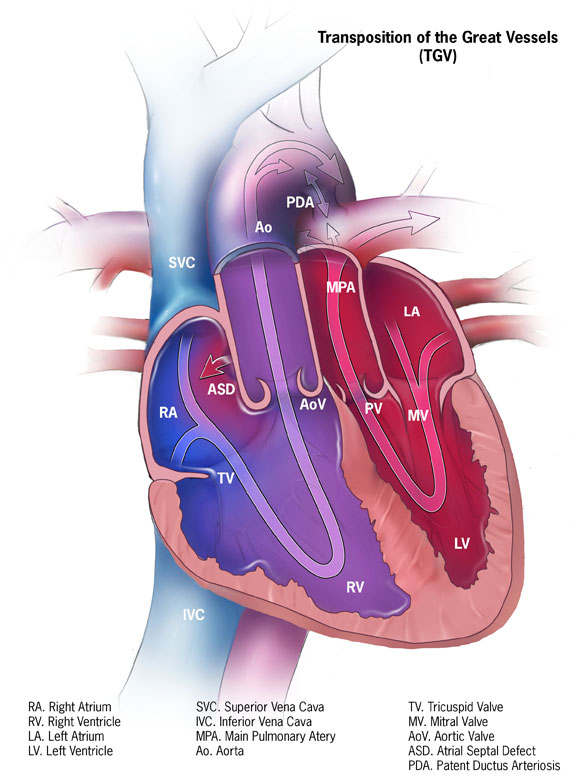[2]
de la Cruz MV,Arteaga M,Espino-Vela J,Quero-Jiménez M,Anderson RH,Díaz GF, Complete transposition of the great arteries: types and morphogenesis of ventriculoarterial discordance. American heart journal. 1981 Aug
[PubMed PMID: 7258100]
[3]
Goor DA,Edwards JE, The spectrum of transposition of the great arteries: with specific reference to developmental anatomy of the conus. Circulation. 1973 Aug
[PubMed PMID: 4726219]
[4]
Improved national prevalence estimates for 18 selected major birth defects--United States, 1999-2001. MMWR. Morbidity and mortality weekly report. 2006 Jan 6;
[PubMed PMID: 16397457]
[5]
Hornung TS,Bernard EJ,Celermajer DS,Jaeggi E,Howman-Giles RB,Chard RB,Hawker RE, Right ventricular dysfunction in congenitally corrected transposition of the great arteries. The American journal of cardiology. 1999 Nov 1;
[PubMed PMID: 10569681]
[6]
Oster ME,Aucott SW,Glidewell J,Hackell J,Kochilas L,Martin GR,Phillippi J,Pinto NM,Saarinen A,Sontag M,Kemper AR, Lessons Learned From Newborn Screening for Critical Congenital Heart Defects. Pediatrics. 2016 May;
[PubMed PMID: 27244826]
[7]
Van Praagh R,Geva T,Kreutzer J, Ventricular septal defects: how shall we describe, name and classify them? Journal of the American College of Cardiology. 1989 Nov 1;
[PubMed PMID: 2808986]
[8]
Ravi P,Mills L,Fruitman D,Savard W,Colen T,Khoo N,Serrano-Lomelin J,Hornberger LK, Population trends in prenatal detection of transposition of great arteries: impact of obstetric screening ultrasound guidelines. Ultrasound in obstetrics & gynecology : the official journal of the International Society of Ultrasound in Obstetrics and Gynecology. 2018 May
[PubMed PMID: 28436133]
[9]
Gopalakrishnan A,Krishnamoorthy KM,Sivasubramonian S, Balloon atrial septostomy at the bedside versus the catheterisation laboratory. Cardiology in the young. 2019 Mar
[PubMed PMID: 30688192]
[10]
Freed MD,Heymann MA,Lewis AB,Roehl SL,Kensey RC, Prostaglandin E1 infants with ductus arteriosus-dependent congenital heart disease. Circulation. 1981 Nov
[PubMed PMID: 7285305]
[11]
Rashkind WJ,Miller WW, Creation of an atrial septal defect without thoracotomy. A palliative approach to complete transposition of the great arteries. JAMA. 1966 Jun 13;
[PubMed PMID: 4160716]
[12]
Jatene AD,Fontes VF,Paulista PP,Souza LC,Neger F,Galantier M,Sousa JE, Anatomic correction of transposition of the great vessels. The Journal of thoracic and cardiovascular surgery. 1976 Sep;
[PubMed PMID: 957754]
[13]
Rastelli GC,Wallace RB,Ongley PA, Complete repair of transposition of the great arteries with pulmonary stenosis. A review and report of a case corrected by using a new surgical technique. Circulation. 1969 Jan;
[PubMed PMID: 5782810]
Level 3 (low-level) evidence
[14]
Hazekamp MG,Gomez AA,Koolbergen DR,Hraska V,Metras DR,Mattila IP,Daenen W,Berggren HE,Rubay JE,Stellin G,European Congenital Heart Surgeons Association., Surgery for transposition of the great arteries, ventricular septal defect and left ventricular outflow tract obstruction: European Congenital Heart Surgeons Association multicentre study. European journal of cardio-thoracic surgery : official journal of the European Association for Cardio-thoracic Surgery. 2010 Dec
[PubMed PMID: 20466558]
[15]
Hutter PA,Kreb DL,Mantel SF,Hitchcock JF,Meijboom EJ,Bennink GB, Twenty-five years' experience with the arterial switch operation. The Journal of thoracic and cardiovascular surgery. 2002 Oct;
[PubMed PMID: 12324738]
[16]
Tobler D,Williams WG,Jegatheeswaran A,Van Arsdell GS,McCrindle BW,Greutmann M,Oechslin EN,Silversides CK, Cardiac outcomes in young adult survivors of the arterial switch operation for transposition of the great arteries. Journal of the American College of Cardiology. 2010 Jun 29;
[PubMed PMID: 20620718]
[17]
Gatzoulis MA,Walters J,McLaughlin PR,Merchant N,Webb GD,Liu P, Late arrhythmia in adults with the mustard procedure for transposition of great arteries: a surrogate marker for right ventricular dysfunction? Heart (British Cardiac Society). 2000 Oct
[PubMed PMID: 10995411]
[18]
Schwartz ML,Gauvreau K,del Nido P,Mayer JE,Colan SD, Long-term predictors of aortic root dilation and aortic regurgitation after arterial switch operation. Circulation. 2004 Sep 14
[PubMed PMID: 15364851]
[19]
Samos F,Fuenmayor G,Hossri C,Elias P,Ponce L,Souza R,Jatene I, Exercise Capacity Long-Term after Arterial Switch Operation for Transposition of the Great Arteries. Congenital heart disease. 2016 Mar-Apr;
[PubMed PMID: 26556777]
[20]
Marino BS, Lipkin PH, Newburger JW, Peacock G, Gerdes M, Gaynor JW, Mussatto KA, Uzark K, Goldberg CS, Johnson WH Jr, Li J, Smith SE, Bellinger DC, Mahle WT, American Heart Association Congenital Heart Defects Committee, Council on Cardiovascular Disease in the Young, Council on Cardiovascular Nursing, and Stroke Council. Neurodevelopmental outcomes in children with congenital heart disease: evaluation and management: a scientific statement from the American Heart Association. Circulation. 2012 Aug 28:126(9):1143-72
[PubMed PMID: 22851541]

